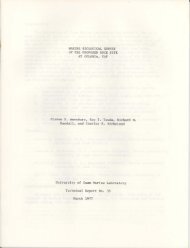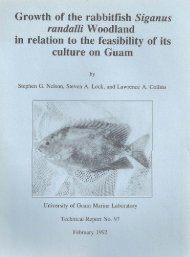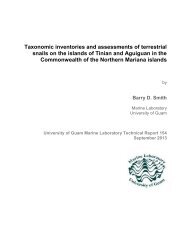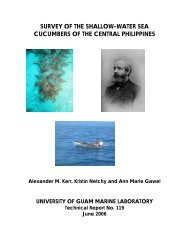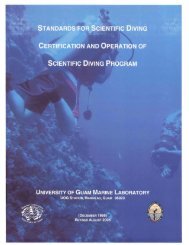Marine Protected Area Surveys Central Visayas, Philippines 2007
Marine Protected Area Surveys Central Visayas, Philippines 2007
Marine Protected Area Surveys Central Visayas, Philippines 2007
You also want an ePaper? Increase the reach of your titles
YUMPU automatically turns print PDFs into web optimized ePapers that Google loves.
Raymundo and Maypa 2008 UOG Tech. Rep. 122<br />
provide information regarding other potential stressors on a reef. In addition, some of these<br />
organisms, such as the Crown-of-Thorns starfish (Acanthaster planci; COTS) and the<br />
corallivorous gastropod Drupella spp., can experience population outbreaks which cause<br />
tremendous coral mortality, and their population numbers should be tracked over time.<br />
Drupella was locally abundant in certain reefs, as were COTS, but we observed no evidence of<br />
outbreaks of either of these organisms in any of our surveyed reefs. Macroalgal abrasion by<br />
Sargassum was occasionally observed, particularly with massive Porites (Figure 7b-A), and<br />
patchy bleaching of unknown cause was common in certain sites.<br />
Southeastern Bohol<br />
Balicasag Island<br />
The Balicasag reef is<br />
characterized by low relief<br />
(Fig. 8); complexity and live<br />
hard coral cover were the<br />
lowest of all sites (Figs. 4<br />
and 5), both inside the MPA<br />
and in the fishing ground.<br />
Substrate was dominated by<br />
pavement, and coral colonies<br />
were small. Pocillopora spp.<br />
and Seriatopora spp. Figure 8. The reef flat and crest community within the<br />
Balicasag <strong>Marine</strong> <strong>Protected</strong> <strong>Area</strong>, showing a reef of low<br />
dominated the coral<br />
complexity, dominated by small coral colonies.<br />
community; both are known<br />
to be rapid colonizers. As was stated in last year’s report, the aggressive coral-killing sponge<br />
Terpios sp. was speculated to be the primary cause of past coral mortality, and was still present<br />
at a depth slightly below the reef crest. However, in spite of past coral mortality, recruitment<br />
within the MPA appears to be quite high, and this has allowed coral cover to increase.<br />
Comparing 2006 and <strong>2007</strong> surveys, live hard coral cover increased from 11% to 21% within the<br />
MPA and from 25% to 29% in the fishing ground. The reef outside the MPA appeared to be less<br />
affected by this sponge, and this is visible in the higher coral cover, larger colonies, and greater<br />
abundance of Porites spp. Fish diversity values were among the highest of all sites, both within<br />
the MPA and in the fishing grounds.<br />
10





